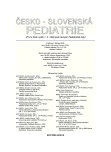-
Medical journals
- Career
Importance of Molecular Genetic Analysis for Diagnosis and Genetic Counseling in Families with Hyperammonemia and Ornithine carbamoyltransferase Deficiency
Authors: L. Dvořáková 1; M. Hřebíček 1; H. Vlášková 1; K. Szentiványi 2; J. Zeman 2
Authors‘ workplace: Ústav dědičných metabolických poruch, 1. lékařská fakulta UK a VFN, Praha přednosta doc. MUDr. V. Kožich, CSc. 1; Klinika dětského a dorostového lékařství, 1. lékařská fakulta UK a VFN, Praha přednosta prof. MUDr. J. Zeman, DrSc. 2
Published in: Čes-slov Pediat 2010; 65 (10): 575-579.
Category: Original Papers
Overview
Ornithine carbamolytransferase deficiency is a severe X-linked disorder presenting with acute hyperammonemic attacks.
The aim is to present clinical data and results of mutation analysis in 34 patients with ornithine carbamoyltransferase deficiency.Patients and methods:
Nine males with severe neonatal form of the disease died in first days of life, 14 patients with late onset form manifested in the 2nd–3rd year of life or in pre-school age; one four-year-old boy and one adult male are asymptomatic. Nine heterozygotes developed symptoms of the disease, one of them in the newborn period, the remaining patients in the 2nd–3rd year of life or at the pre-school age. The diagnosis based on evaluation of analyte concentration in blood plasma and urine was confirmed by methods of mutation analysis.Results:
The results of analyte profiling (ammonia and glutamine/glutamate concentrations in blood serum and orotic acid in urine) did not predict the phenotype and only partially correlated with the actual health state of the patient. Gross deletions and other obviously null mutations were invariably associated with the neonatal form of the disease. Some missense mutations caused neonatal form, while others were associated with late onset of the disease. Mutation analysis in patient’s families showed that affected boys usually inherit OTC mutations from their heterozygous clinically unaffected mothers, while de novo mutations occur more frequently in manifestingheterozygotes.Conclusions:
OTC deficiency is a severe disease in which precise and fast diagnosis plays an important role. Molecular genetic diagnosis is essential for confirmation of the diagnosis, genetic counseling and possible prenatal diagnosis in affected families.Key words:
urea cycle, OTC deficiency, mutation analysis, genotype-phenotype correlation, de novo mutation
Sources
1. Brusilow SW, Horwich AL. Urea cycle enzymes. In Scriver CR, Beaudet AL, Sly WS, Valle D (eds.). The Online Metabolic and Molecular Bases of Inherited Disease. New York: McGraw Hill, Inc., 2004. Chap. 85. www.ommbid.com.
2. Horwich AL, Fenton WA, Williams KR, et al. Structure and expression of a complementary DNA for the nuclear coded precursor of human mitochondrial ornithine transcarbamylase. Science 1984; 224 : 1068–1074.
3. Lyon MF. X-chromosome inactivation and human genetic disease. Acta Paediatr. Suppl. 2002; 91(439): 107–112.
4. Carrel L, Willard HF. X-inactivation profile reveals extensive variability in X-linked gene expression in females. Nature 2005; 434 : 400–404.
5. Keskinen P, Siitonen A, Salo M. Hereditary urea cycle diseases in Finland. Acta Paediatr. 2008; 97(10): 1412–1419.
6. Pařízková E, Rozsíval P, Freiberger T, et al. X-vázaná hypogamaglobulinémie (Brutonova nemoc) – tři kazuistiky a molekulárně genetické studie jejich rodin. Čes.-slov. Pediat. 2004; 59 : 119–122.
7. Dvořáková L, Hřebíček M, Jahnová H, et al. X-vázaná adrenoleukodystrofie u jednadvaceti českých pacientů. Čes.-slov. Pediat. 2006; 61 : 129–136.
8. Luksan O, Jirsa M, Eberova J, et al. Disruption of OTC promoter-enhancer interaction in a patient with symptoms of ornithine carbamoyltransferase deficiency. Hum. Mutat. 2010; 31: E1294–1303.
9. Tuchman M, Jaleel N, Morizono H, et al. Mutations and polymorphisms in the human ornithine transcarbamylase gene. Hum. Mutat. 2002; 19 : 93–107.
10. Yamaguchi S, Brailey LL, Morizono H, et al. Mutations and polymorphisms in the human ornithine transcarbamylase (OTC) gene. Hum. Mutat. 2006; 27 : 626–632.
11. Bonaïti-Pellié C, Pelet A, Ogier H, et al. A probable sex difference in mutation rates in ornithine transcarbamylase deficiency. Hum. Genet. 1990; 84(2): 163–166.
12. Tuchman M, Matsuda I, Munnich A, et al. Proportions of spontaneous mutations in males and females with ornithine transcarbamylase deficiency. Am. J. Med. Genet. 1995; 55(1): 67–70.
13. Oppliger Leibundgut E, Liechti-Gallati S, Colombo JP, et al. Ornithine transcarbamylase deficiency: ten new mutations and high proportion of de novo mutations in heterozygous females. Hum. Mutat. 1997; 9 : 409–411.
Labels
Neonatology Paediatrics General practitioner for children and adolescents
Article was published inCzech-Slovak Pediatrics

2010 Issue 10-
All articles in this issue
- Specific Aspects of Selected Sleep Disorders in Childhood
- Prenatal Effects of Alcohol
- Treatament of Tobacco Dependence – New, Important and Difficult Medical Topic
- Some Controversies in Gynecology and Obstetrics
- Prophylaxis of Early-onset Streptococcal Sepsis in Newborn Infants
- Hospitalization of Children for Bronchiolitis in Slovakia in 1996–2006
- Importance of Molecular Genetic Analysis for Diagnosis and Genetic Counseling in Families with Hyperammonemia and Ornithine carbamoyltransferase Deficiency
- Fetomaternal Haemorrhage as a Cause of Severe Neonatal Anaemia
- Procedural Pain in the Newborn: Possible Prevention and Mitigation
- The Problems of Short Frenulum
- Czech-Slovak Pediatrics
- Journal archive
- Current issue
- Online only
- About the journal
Most read in this issue- The Problems of Short Frenulum
- Prenatal Effects of Alcohol
- Prophylaxis of Early-onset Streptococcal Sepsis in Newborn Infants
- Fetomaternal Haemorrhage as a Cause of Severe Neonatal Anaemia
Login#ADS_BOTTOM_SCRIPTS#Forgotten passwordEnter the email address that you registered with. We will send you instructions on how to set a new password.
- Career

